Clinical Center volunteers fill demand for interpreters
One evening in 1975, about two weeks after Chi Vu's family came to the United States from Vietnam, Vu's sister had a seizure. Not having learned English yet, the family could not call for help. They ran to their neighbor's house, and the neighbors called 911.
"When the paramedics came, none of us could communicate with them," Vu said. "We didn't know what to do. My father, who spoke and understood just a very little English, went with my sister to the hospital emergency room, but to this day, we still don't know what really happened to her, or why she had a seizure.
"When my sister came home from the hospital she was fine, but it was a very frightening experience," Vu said. "We were all crying. It is very hard to not be able to communicate, especially in such a stressful situation where illness is involved."

|
Chi Vu, DLM, has been volunteering as a hospital interpreter since she was in college.
|
Following that incident, Vu, a medical technologist in the Clinical Center 's Department of Laboratory Medicine, decided that when she was able to, she was going to help others who were in similar circumstances as her family had been that night.
Vu started to volunteer as a translator at a local hospital when she was in college and signed up for the Clinical Center 's Volunteer Interpreters Program when she came to NIH in 1990. The volunteers now help non-English speaking patients who are enrolled in NIH clinical trials cope with life in the hospital, and in many cases, the community as well.
Andrea Rander, the program's director, said that since she joined the Clinical Center 15 years ago, she has seen a marked increase in the number of foreign patients at the hospital as well the demand for interpreters.
"In 1990 we had only two volunteer interpreters for Spanish. We now have more than 100 interpreters for about 60 different languages in our data bank," Rander said. "They are a group of dedicated people from many ethnic backgrounds who speak many different languages."
The program has two staff interpreters, Jose Rosado-Santiago and Maria Rudulovic. Together they can interpret for patients who speak Spanish, French, Italian, German, and Creole. The other interpreters are volunteers, mostly Clinical Center employees, but also from other places on the NIH campus and some from the community.
The program recruits volunteers in several ways, Rander explains. "During Clinical Center orientation, new employees are informed about the program, so that bilingual employees who are interested in volunteering can call us to offer their services. Occasionally, if we can't find an interpreter for a patient and are desperate, we may do an overhead page in the building, hoping for a response. A less conventional recruitment method is approaching people 'on the street,' so to speak. I once saw a physician in the cafeteria whom I thought might speak Urdu, a language of India and Pakistan , which we needed an interpreter for. I asked her if she knew the language and, although she didn't, she led me to someone in the community who did."
Rander stresses that it is important for nurses and doctors to alert her early about protocols that will be enrolling patients who require an interpreter. Recent challenges have been finding interpreters for patients from Mongolia , Indonesia , and Romania . "The more advance notice we have, the better our chances are of finding someone on staff or in the community."
Sometimes relatives can help out, she said, "but they cannot interpret documents like consent forms and protocols. The subject matter is very technical and must be interpreted precisely. Also, aspects of the consent or protocol can be too emotion-laden for a relative to handle. That's why NIH employees are ideal interpreters – they often are familiar with protocols and protocol structure. That helps us and the patient."
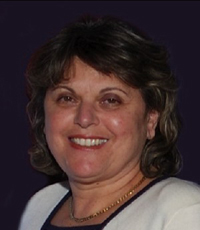
|
While interpreting for patients, volunteer Barbara Brandys often finds herself mediating cultural misunderstandings.
|
Barbara Brandys, an informationist at the NIH library, is also a volunteer interpreter. Brandys's native tongue is Polish, but she is also fluent in Russian, English, and Hebrew. She studied Russian and English in school in Poland and Hebrew in Israel when her family moved there after she graduated high school.
Interpreting for patients sometimes involves more than just translating the language, Brandys said. Sometimes volunteers are called upon to be a bit of a mediator when a conflict arises as the result of a culture gap. This happened with an orthodox Jewish patient from Israel for whom Brandys was interpreting.
"The doctors had scheduled tests for him on Friday afternoons," Brandys said. "This presented a problem, because the Jewish Sabbath begins Friday evening at sundown. The doctors didn't see a conflict, since the Sabbath wasn't until Friday night."
Brandys explained to the staff that the people who drive the patient to and from the clinic are also orthodox Jews, and they needed to be home before the Sabbath begins. Since sundown is very early in the wintertime, it would have been impossible for them to bring the patient for tests at 3:00 p.m. and be back home before sundown.
"In the end, we negotiated for other doctors to care for him on Thursdays. The patient was very grateful, and I was happy for him," Brandys said.
Interpreters sometimes find them-selves on call after work hours as well. Vu said that patients sometimes call her at home in the evening if they can't find someone to help them, and sometimes she arranges three-way telephone conversations between herself, the patient, and the doctor. It is not uncommon for patients to also request help from interpreters with problems unrelated to their medical needs. Both Brandys and Vu have helped patients find housing in the community and have steered them to places in the community for shopping and other daily needs.
Vu and Brandys both enjoy interpreting and find it interesting to learn about the patients and about diseases and the procedures used to treat them. On one occasion, Vu said, it even afforded her an opportunity to learn a bit about herself and to alter her own thinking.
"A few years ago I was asked to interpret for young twin girls who came to the Clinical Center from North Vietnam , and whose family were communists. Because of my background, I hesitated at first to help them, but I quickly realized that I needed to put aside my political differences and do what I could to help. It turned out to be a pleasant experience, and I was able to learn something about their lives in North Vietnam ."
The interpreters find that they often develop personal relationships with "their patients," as they sometimes refer to those they interpret for. Brandys has been invited to weddings and Bar Mitzvahs in Israel , and Vu has been invited to visit patients who have returned to Vietnam . Both appreciate these gestures, but mostly, they are gratified by the knowledge that they are helping to ease anxiety and tension under difficult circumstances. "The patients are always thankful and happy to see me come into their room," said Vu, "and that gives me a good feeling."
An often overlooked, but key ingredient in the success of the Volunteer Interpreters Program, is the role of the interpreters' supervisors. "Without their support, the program could not provide the high quality of service it does," Rander said. "They understand volunteerism and the important function of our interpreters."
In addition to everything else, Rander notes that the volunteers also provide a cost savings because interpreting can be a very expensive proposition. "And they ask for nothing in return," she said, "not even recognition. They simply want to provide a good service because they understand it is needed."
For more information on the Volunteer Interpreters Program and how to become a volunteer, call Andrea Rander at 301-496-1807.
- Marian Segal
Back to Top
Atkinson is honored by the American Society for Clinical Pharmacology and Therapeutics

|
CC Director John I. Gallin (L) congratulates Dr. Arthur Atkinson (R) on his Hunter award. Dr. Michael Rogers, NIGMS, looks on.
|
Dr. Arthur J. Atkinson, Jr., senior advisor in clinical pharmacology to the CC director, received the 2005 Oscar B. Hunter Memorial Award in Therapeutics from the American Society for Clinical Pharmacology and Therapeutics (ASCPT) in Orlando , Fla. on March 3.
"This is the capstone of a lifetime of work in clinical pharmacology," said Atkinson. "The award is inter-nationally regarded. There is no greater honor is this field."
Atkinson directs the ClinPRAT post-doctoral training program, the CC course "Principles of Clinical Pharmacology," and a computer workshop on "Principles of Pharmacokinetic Data Analysis: Modeling and Simulation."
He received his A.B. degree in chemistry from Harvard College , graduated from Cornell University Medical College in 1963 and was an intern and resident at Massachusetts General Hospital . He was a clinical associate in the Laboratory of Clinical Investigation at NIAID and he received postdoctoral training in clinical pharmacology at the University of Cincinnati . He was a visiting scientist in the Department of Toxicology of the Karolinska Institute and he started the Northwestern University Medical School program in clinical pharmacology in 1970. In 1994, Atkinson joined the Upjohn Company as corporate vice president for Clinical Development and Medical Affairs.
Atkinson is a master of the American College of Physicians and has been president of the Chicago Society of Internal Medicine, the American Board of Clinical Pharmacology, and the American Society for Clinical Pharmacology and Therapeutics. He is an associate editor for the ASCPT journal, Clinical Pharmacology and Therapeutics, and the ASPET journal, Pharmacological Reviews.
The Oscar B. Hunter Memorial Award in Therapeutics honors individual scientists for their outstanding contributions in drug research, patient care, and teaching. The award is named for Washington , D.C. , physician, Dr. Oscar Benwood Hunter, Sr., whose father and grandfather were also physicians. Hunter was an active ASCPT member who held the offices of secretary and president.
Previous Hunter award winners include Nobelists Charles B. Huggins (1962), George H. Hitchings (1984) and former Nobel committee member Folke Sjöqvist (1996). Honorees also include Jonas E. Salk (1955), Albert B. Sabin (1963), Louis Goodman (1976) and Alfred Gilman (1976).
Members of the American Society for Clinical Pharmacology and Therapeutics are leading the development and evaluation of new drugs and defining best practices for drug usage.
Back to Top
Jerry Taylor retires
Jerrlynn (Jerry) Taylor retired from the CC Materials Management Department in March after a 42-year career. A graduate of the nursing programs at Hahnemann Medical College and the University of Pennsylvania , Philadelphia , she holds advanced degrees in nursing and education from Pennsylvania State University and the University of Pennsylvania .
"I have enjoyed my journey and would do it all again," she says. "My years at the Clinical Center have been most rewarding and productive. All of the staff that I have associated with are top of the line. Their dedication to patient care is outstanding."
Taylor joined the CC Nursing Department in 1990. She used her clinical and administrative experiences to develop and teach many new concepts to the nursing staff. In 1992, Taylor became the first nurse consultant to join the Materials Management Department. There she designed a new clinical equipment program. She recently managed the clinical operational budget for the new CRC. This included all the new beds, stretchers, exam tables and other clinical accessories for the new hospital. During her 15 years at the Clinical Center , Taylor has received six Director's Awards.
She came to the CC from the George Washington University Medical Faculty Associates Program where she was director of the Ambulatory Cancer Center . Prior to that she was at the Pennsylvania State Hershey Medical Center for 10 years as nursing coordinator of critical care and then as clinical nurse specialist for the Home I.V. Therapy Programs. Taylor says her career has taught her that, "excellence in customer services at all levels creates an atmosphere of trust, harmony and quality that helps ensure safety in services and in patient care."
Now that she's retiring, she plans to travel with her retired husband and devote time to her new home, granddaughter, and perhaps learn to play golf.
Back to Top
Exercise offers opportunity to practice life in the CRC
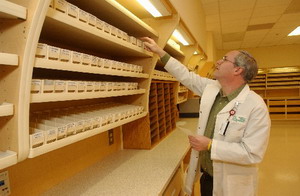
|
Pharmacist Barry Goldspiel simulates filling routine and STAT medication orders in response to scenarios taking place on the patient care units.
|
Because of many years of practice and preparation, staff in the 'old' hospital have the routines and contingencies down pat. How will it all work once the Mark O. Hatfield Clinical Research Center is activated? On March 4, a multifaceted "day in the life" exercise provided staff the opportunity to practice a series of real-life situations.
Planners developed scripts and scenarios that focused on everything from missing patients and unruly visitors to STAT pharmacy orders and routine meal delivery. Fire alarms were tested and building evacuation simulated.
"Staff from throughout the Clinical Center participated in the exercise," said Dr. John I. Gallin, CC director. "Their enthusiasm enabled a truly realistic test of how we'll work in the new environment. We identified some areas we'll need to focus on operationally, and overall we're looking forward to a smooth transition."
Participants gathered for a comprehensive review at the end of the four-hour exercise, discussions that will help guide final preparations for hospital activation on April 2.
|

|
Admissions staffer Steve Yen greets model patient Darice Stephenson as she arrives in admissions. This scenario tested the routine admission process and the staff’s ability to provide clear directions to inpatient units.
|
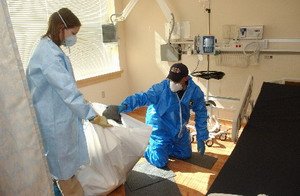
|
Kristine Simpson and the fire department clean up a fake chemo spill in a patient room on 3 NW.
|
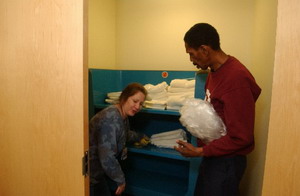
|
Errol Smith, supply technician in Housekeeping & Fabric Care, delivers linen to 5NE patient care unit.
|
|
|
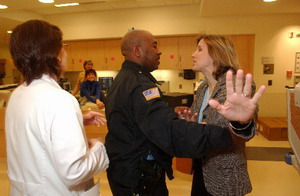
|
An irate Maureen McDonnell simulates being subdued by Officer Brian Sims, NIH police, after ICU staff activates the "duress button."
|

|
Nurses Ann Mulqueen and Barbara Whiting interact with Lt. Joe Cox, Sgt. Gerry Jordan, and Officer Brian Sims of the NIH Police after reporting a missing patient on 1SW. This scenario tested how to conduct coordinated search for a missing person in a new environment.
|

|
Nurse Ann Marie Matlock and Tam Cillie, respiratory therapist, set up oxygen for their model patient Amy Garner-Obrien in the ICU.
|
|
Back to Top
Patient safety award goes to 3 East PCU

|
Front row: Teachers Ann Davidson and Susan Job; and nurses Patricia Evans, Julia Mitchell, Danielle Gabrielle, and Diane Lawrence.
Back row: Dr. Julia Tossell, Ann Mulqueen, Christian Mbulu, Dr. Gallin, Georganne Kuberski, Andre Caple, Tom Houston, Dr. Ken Towbin, and Camille Grigg. Mulqueen, Kuberski, Houston, and Grigg are nurses. Nbulu and Caple are behavior health technicians. Drs. Tossell and Towbin are with NIMH.
|
The Clinical Center 's first Patient Safety Champion Award has been awarded to the nursing and patient care staff of 3 East. The award will be given annually to individuals or teams demonstrating a sustained commitment to creating and maintaining a safe environment for patients.
On 3 East, a unit that supports an acute care pediatric behavioral health program, staff use a philosophy of "supportive care" in assisting children throughout the research process. Protocols typically include difficult medication tapers and medicine-free phases. "Individualized behavior and treatment plans are developed and implemented by an expert team of nurses and behavior health technicians," said Georganne Kuberski, nurse manager, pediatric behavior health.
"The staff recognized a need for and implemented as-needed Clinical Case Conferences to bring the nursing team together to address and have input into the management of a particularly difficult or aggressive child, utilizing the combined experience and expertise of a number of team members in the formulation of Aggressive Behavior Management plans," said Kuberski.
As result of the staff's actions, injuries to both patients and staff and incidents that resulted in placing patients in seclusion or restraints were reduced by 70 percent over the course of six months.
"The 3E staff have tapped amazing talent in being able to respond to our research participants with compassion, respect, and safety," said Dr. Ken Towbin, NIMH investigator. "This achievement is all the more impressive when one considers that this is an ultra high-risk population. First they are children who developmentally are less inhibited and have poorer judgment about their behavior. Second, they are recruited to the Clinical Center for symptoms, among others, of explosive and aggressive outbursts that cause impairment at home and outside their homes. And third, on our protocols they are gradually taken off all medication leaving them vulnerable to more impulsivity and aggression."
Dr. John I. Gallin, CC director, presented the award during a March 10 reception for recipients. The ceremony was part of the CC's observance of National Patient Safety Week.
Back to Top
Sickle Cell Anemia outreach event set for April 23
"Sickle Cell Anemia: Moving Beyond Pain" is an outreach event for prospective patients and the public. The event will take place April 23, from 10:30 am–2 pm, in the first floor atrium of the Mark O. Hatfield Clinical Research Center .
Sickle cell anemia affects millions of people throughout the world. In the U.S. alone, about 72,000 people are diagnosed with the condition. It occurs in about one in every 500 African-American births and one in every 1,200 Hispanic-American births.
The NIH Clinical Center and the National Heart, Lung, and Blood Institute sickle cell clinical research team are hosting the event to share information about the disease, symptoms and complications, diagnosis, and treatment.
Representatives from the health-care research team will share information and be available to answer questions about the disease, including scientific advances, current research efforts and development of new treatments.
The event is free and open to the public. For more information call 301-435-2345.
Back to Top
Charles Minters retires
|
After 31 years of dedicated service to the Materials Management Department, supply technician Charles Minters is retiring.
Minters came to NIH in 1974 in the Housekeeping Department and joined Materials Management in 1978, performing various duties such as receiving, storing and issuing materials, supplies and equipment. He also assisted in physical inventory and maintenance of the storage areas. Since retiring, Minters is enjoying his time with his wife of 29 years, Norma, and his two daughters and six grandchildren. Norma has been employed with NIMH for 29 years and plans to join her husband in retirement in 2008. "There are so many people I'd like to thank at NIH for their support during my time here," Minters said. "It's been a very enjoyable and fulfilling career and everyone I've worked with will be deeply missed."
|
|
|
Back to Top
Graduate programs for nurses provide specialized experience
Graduate nursing programs provide experience in a clinical specialty, and this spring, participants in the oncology nurse fellowship and the neuroscience nurse internship will graduate.
"These programs offer nurse graduates the experience needed to launch their professional nursing careers in a clinical specialty," said Cynthia Herringa, nurse consultant, Office of Recruitment Outreach Orientation and Retention, Department of Nursing and Patient Care Services.
The oncology nurse fellowship is a new graduate program with clinical and didactic training in disease-specific cancers, cancer genetics, clinical re-search, pain and palliative care, and complementary and alternative treatments, followed by a custom designed independent study experience. "Classes are taught by experts in their fields," said Debra Parchen, fellowship program coordinator. Clinical research training includes instruction in roles of the research team, ethics, informed consent and protocol implementation.
The program provides a strong foundation for the national oncology nursing certification, Parchen added.
The neuroscience nurse internship program provides nurses with a basic knowledge and understanding of both neuroscience and neuroendocrine nursing. Established in 1988, the internship is sponsored by the CC and the National Institute of Neurological Disorders and Stroke. "We want to enable nurses to provide clinically competent care to their patients and transform the interns into clinical generalists in these areas," said Beth Price, internship coordinator. "We also want to increase the number of clinically competent nurses in neuroscience and neuroendocrine and to prepare them to function as members of the biomedical research team."
Three graduate training programs are scheduled for 2005-2006: the medical surgical nurse internship, the pediatric nurse internship, and the oncology nurse fellowship, which is currently the only nurse internship conducted annually. The neuroscience program is offered every other year. For further information, call 800-732-5985.
|

|
Members of Class 15 of the Neuroscience Nurse Internship Program
First row L to R: Kaylan Fenton, Charmika Schuster and Frances McCarey.
Back row L to R: Amanda Funkhouser-James, Jennifer Hunt, Alexander Ober and Beth Price, program coordinator.
|
|
|
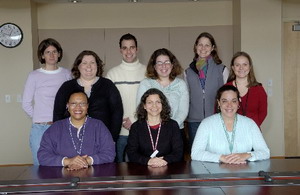
|
Members of the Cancer Nurse Fellowship Program
First row L to R: Carol Chandler, Annemarie Spletzer, Edalia Cedeño
Second row L to R: Leigh Kiger, Nicole Droog, Keelin Cromar
Third row L to R: Laura Jeffers, Keith Marin and Adrienne Cronk
|
|
Back to Top
April Calendar
| April 6 |
|
Noon – 1 pm Lipsett Amphitheater
Grand Rounds, Ethics Sharing Results of Genetic Research Tests with Minors
Kurt Hirschhorn, M.D., Professor Emeritus, Department of Pediatrics, Mount Sinai School of Medicine
3 p.m. Masur Auditorium
The NIH Director's Wednesday Afternoon Lecture Neutrophil Polarity and Direction-Finding
Henry R. Bourne, M.D., Professor, Medicine and Cellular and Molecular Pharmacology, University of California , San Francisco
Hosts: The Immunology Interest Group and National Institute of Allergy and Infectious Diseases
|
| April 13 |
|
Noon – 1 pm Lipsett Amphitheater
Grand Rounds, Great Teachers Age-Related Macular Degeneration: Scourge of the Elderly but Hope for the Future
Stuart L. Fine, M.D., Professor of Ophthalmology; Chairman, Department of Ophthalmology, Director, Scheie Eye Institute, University of Pennsylvania Health System
3 p.m. Masur Auditorium
The NIH Director's Wednesday Afternoon Lecture Commitment and Cannibalism in a Bacterium
Richard Losick, Ph.D., Maria Moors Cabot Professor of Biology, Harvard College Professor, HHMI Professor, Harvard University , Cambridge
Host: The Lambda Lunch Interest Group
|
| April 20 |
|
Noon-1 p.m. Lipsett Amphitheater
Grand Rounds Chronic Kidney Disease in the United States : Prevention, Detection and Treatment
Thomas Hostetter, M.D., Director, National Kidney Disease Education Program, Senior Scientific Adviser, National Institute of Diabetes and Digestive and Kidney Diseases
Focal Segmental Glomerulosclerosis: A Common Cause of Renal Disease in Minorities
Jeffrey Kopp, M.D., Staff Clinician, Kidney Disease Section, Metabolic Diseases Branch, National Institute of Diabetes and Digestive and Kidney Diseases
3 p.m. Masur Auditorium
The Director's Wednesday Afternoon Lectures A Two-Billion Year Old Tale of the Mechanisms of Transmembrane, Transport Elucidated at the Level of Atomic Structures
Robert M. Stroud, Ph.D., Professor of Biochemistry and Biophysics, Professor of Pharmaceutical Chemistry, Department of Biochemistry and Biophysics, University of California, San Francisco
Hosts: The X-Ray Diffraction and Structural Biology Interest Groups
|
| April 22 |
|
11 a.m. Masur Auditorium
Integrative Medicine: A Foundation for Prospective Health Care
Ralph Snyderman, M.D., Chancellor Emeritus, Duke University , James B. Duke Professor of Medicine, Visiting Professor at University of California , San Francisco Sponsored by NCCAM
|
| April 27 |
|
Noon – 1 pm Lipsett Amphitheater
Grand Rounds Clinical Microbiology: The Role of Genomics in Diagnostic Testing
Patrick Murray, Ph.D., Chief of Microbiology, Department of Laboratory Medicine, National Institutes of Health Clinical Center
That "Spring" in Your Step: Dynamic Joint Bracing for Enhanced Function
Steven Stanhope, Ph.D., Director, Physical Disabilities Branch, Rehabilitation Medicine Department, National Institutes of Health Clinical Center, National Institute of Child Health and Human Development
3 p.m. Masur Auditorium
The Director's Wednesday Afternoon Lectures Transcriptional Control of Immunological Tolerance
Diane Mathis, Ph.D., Head, Section on Immunology and Immunogenetics, Joslin Diabetes Center , Professor of Medicine, Harvard Medical School , Boston
Host: National Institute of Diabetes and Digestive and Kidney Diseases
|
|
* Some lectures can be accessed on the NIH videocast at http://videocast.nih.gov.
|
Back to Top
|


 The information on this page is archived and provided for reference purposes only.
The information on this page is archived and provided for reference purposes only.